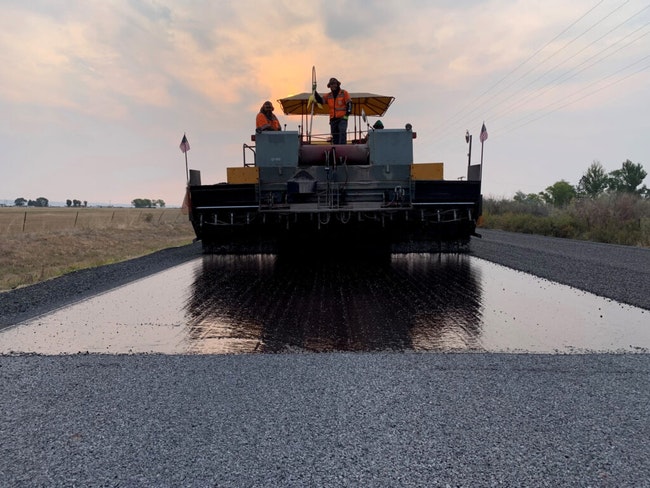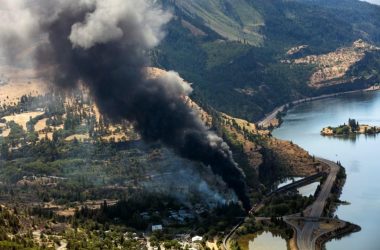
State agencies are planning for unexpectedly high fuel prices. Asphalt costs are expected to climb. (Oregon Department of Transportation)
Gasoline is both the hand that gives and the hand that takes at the Oregon Department of Transportation. For its funding, the agency relies on taxes collected from statewide gas sales. To power road crews, mowers and snow plows, it has to buy about three million gallons of gas and diesel a year.
When prices are high, the department struggles to afford its own fuel and Oregon drivers, who pay the gas tax at the pump, end up driving less and buying less gas, shrinking the department’s revenue.
It’s one of the many inconspicuous ways that rising fuel prices impact state agencies that still rely on combustion engines and have to travel over many miles to do their work.
Mac Lynde is an operations administrator at the Transportation Department.
“Costs are going up exponentially right now with the pandemic supply chain issues and asphalt prices will go up with oil. It’ll force us to make some tough decisions,” Lynde said. “It could mean less pavement overlays, less chip seals on rural roads, less of the bigger maintenance things we do.”
The average price of a gallon of regular gas for Oregonians hit $4.74 Friday, according to Oregon AAA. That’s 70 cents higher than the week prior and $2 more than a year ago.
The recent spike is due to the Russian invasion of Ukraine, which has disrupted the global oil trade and supply chains and is likely to keep gas prices high, according to economists.
Oregon’s Department of Administrative Services negotiates a reduced bulk fuel rate for state agencies, and employees fill up at specific bulk fuel sites.
For a gallon of regular right now, bulk fuel users pay about $1 less per gallon than retail, and for diesel, about $1.20 less per gallon. Still, prices shot up by more than a third in the last month, and the Administrative Services Department expects it will be up 50 cents more within the next week.
When state employees aren’t near a bulk fuel site, they pay the retail price just like everyone else.
The Transportation Department expects that at current prices, it could end up paying $3.5 million more for fuel in the next year.
Andrea Chiapella, communications director at the Administrative Services Department wrote via email that agencies that receive the bulk fuels rate are expected to get by with the budgets they currently have into 2023. Agencies can reach out to Administrative Services for emergency fuel budget adjustments, but it hasn’t yet heard from anyone.
“It may be too early to tell,” Chiapella wrote.
Department of Fish and Wildlife
The state’s Fish and Wildlife Department relies on trucks, all-terrain vehicles and boats to do its work, and it too faces inconspicuous costs if gas prices go up.
Fish and Wildlife collects most of its money not from the state’s general fund, but from the sales of hunting and fishing licenses.
According to Shannon Hurn, deputy administrative director at Fish and Wildlife, when gas prices go up, fewer of those licenses are sold.
In 2008, when gas prices were at their last record high – an average of $4.11 per gallon – the department did an analysis on the economic impacts.
“The bulk of our funding comes from participation in wildlife consumptive activities,” Hurn said. “We found that participation in these activities is tied to the price of gas, not the cost of licenses.”
Hurn said the department is looking at 2008 as a template for how to navigate the budget shortcomings it anticipates in the months ahead.
The 2008 surge forced the agency to restrict statewide travel, stopped employee trainings and put some habitat restoration projects on hold.
“This could determine whether we go out into the field as much, it could delay hirings, the purchase of equipment,” Hurn said.
Fish and Wildlife gets some federal funding, so more of that could help balance losses, but even that is tied to federal excise taxes on the sale of, among other things, gasoline.
“Rebuilding a fish passage structure, that’s $1 million dollars,” Hurn said. “We have contractors covering large distances. The costs of that restoration work will get inflated.”
She expects long-term research and habitat restoration projects to get sidelined in order to save money. The department can’t afford to scale back its budget for dealing with emergencies, such as handling animal and wildlife encounters.
“When people think of wildlife management, I don’t know if they realize there really is a lot that gets done. We do surveys, research, manage fish harvests, but our work also focuses on picking up ill and injured animals, helping private landowners. You’ve got a cougar in downtown Portland? We have to be available.”
Because Fish and Wildlife doesn’t receive money from the state’s general fund, it doesn’t have many options for requesting emergency funding.
“We don’t get to shift around money. We don’t get to go to the legislature and ask for additional funds through the emergency board,” Hurn said.
For now, it’s likely that project by project, teams within the agency will have to find a way to balance the budgets they already have until 2023.
“If projects run out of money, then they won’t be able to start again until 2023 when they have a newly adopted budget,” Hurn said.
Oregon State Police
State police employees drive more than a million miles per month, according to Mindy McCartt, communications director for the Oregon State Police, but she could provide no information on how the agency is coping with current fuel costs and the increases likely to come.
McCartt said any adjustments to the department’s $4.9 million biennial fuel budget will be a “wait and see game.”
The agency is halfway through its budget cycle and has time to adjust according to how big a hit it takes on gas prices. If prices remain above $4 per gallon for the next year, McCartt said, the agency will need to double its fuel budget to at least $8 million for the next biennium.
Because the agency gets most of its funding from the state’s general fund, McCartt said that it can request emergency money through the state Emergency Board.
Getting off gasoline
For the Transportation Department, planning for a future without gasoline has been a long time coming.
Shelley Snow, communications director at the department, said it’s been pushing for more than 20 years to come up with a plan.
“We’ve been talking to every legislature since 1999 in earnest about this, saying ‘Hey, in the future there are going to be a lot of electric vehicles on the roads and vehicles that get high mileage per gallon. Since we get our money from a tax on every gallon of gas sold, we need to start thinking about this,’” she said.
Currently, electric vehicle owners can opt into a program that taxes them by their mileage, measured by a plugin they put in their car, and money goes to the Transportation Department. Snow said it’s likely that will have to be a requirement in all electric cars in the future in order to finance the Transportation Department.
The Transportation Department and Fish and Wildlife are interested in electrifying their fleets as quickly as possible, but shortages of electric trucks caused by supply chain issues mean it could be years before either agency gets even a dozen or more of these vehicles.
Fish and Wildlife currently has about 1,300 employees and 650 vehicles in its fleet, and it typically borrows another 80 to 100 from the Administrative Services Department to use for surveying during the summer, their busiest time of year.
Hurn said the Administrative Services Department has about five electric trucks to lend out, but they aren’t well equipped to handle the remote projects Fish and Wildlife works on because of the dearth of charging stations throughout the state.
The Transportation Department is also hopeful it can get electrified fleets in the future, but the supply is just not there.
“We have orders in for electric pickups right now that cannot be fulfilled,” said Lynde, the operations administrator at the department.
“We’d like to advance faster, but the reality is the market right now is directed at individual consumers and less at full fleets,” he said.
On the bright side, when fuel prices are up, more people tend to use public transit. The Transportation Department expects that, as in 2008, ridership will increase on trains and buses. But, as in the years since 2008, Lynde expects the impacts of high fuel prices now will be felt for many years ahead on the road.
“We probably never really catch back up,” he said about projects that get paused due to higher costs. “We are always managing a declining investment in what’s needed.”
Oregon Capital Chronicle is part of States Newsroom, a network of news bureaus supported by grants and a coalition of donors as a 501c(3) public charity. Oregon Capital Chronicle maintains editorial independence. Contact Editor Les Zaitz for questions: [email protected]. Follow Oregon Capital Chronicle on Facebook and Twitter.









